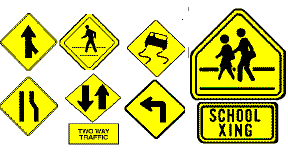You scored 100 points out of 100 points total.
Upon completion of a quiz, you will get something like this:
Congratulations – you have completed Ten Questions You May Find on the Drivers License.
Your answers are shown below:
1.
What is the usual color and shape of a Warning Sign?
- White rectangles with black lettering or symbols.
- Yellow and diamond-shaped with black lettering or symbols
- Red and white with red letters.
- Blue with white symbols
- Green and white squares
2.
What is the color and shape of a Railroad Sign?
- Orange triangle
- Yellow and black circle with an “X”
- Black and white rectangle
THE SHAPE AND COLOR OF SIGNS differ WITH THE TYPE OF INFORMATION THEY PROVIDE:
You may be asked the color and shape of different types of signs:
YOU MUST BE ABLE TO RECOGNIZE AND KNOW ALL SIGNS.

REGULATION SIGNS
REGULATION SIGNS ARE USUALLY WHITE RECTANGLES WITH BLACK LETTERS OR SYMBOLS
SOMETIMES THEY MAY USE RED LETTERS OR SYMBOLS
TIP – They are regulating something, your speed, turns, etc.

WARNING SIGNS
WARNING SIGNS ARE YELLOW WITH BLACK LETTER/SYMBOLS DIAMOND SHAPE AND SOMETIMES COMBINED WITH A RECTANGULAR “RECOMMENDED SPEED” SIGN
TIP – They are warning you of conditions ahead.
DESTINATION SIGNS
DESTINATION SIGNS
GREEN WITH WHITE LETTERING
SHOWING DISTANCES AND DIRECTIONS TO VARIOUS LOCATIONS
| Your town USA 25 Miles. . . . . |
SERVICE SIGNS
SERVICE SIGNS ARE BLUE WITH WHITE LETTERING
SHOWING LOCATION OF HOSPITALS, GAS AND REST AREAS ETC.
SOME EXAMPLES ARE:
| H |
Hospital next exit
RAILROAD CROSSING SIGNS:
Yellow with black letters and “X” symbol
We have just created a new quiz dedicated only to signs. Check it out here!
REGULATION SIGNS
WARNING SIGNS
DESTINATION SIGNS
INFORMATIONAL SIGNS
3.
How many feet before turning should you signal?
- 50 feet
- 100 feet
- 200 feet
Signal before you turn ALWAYS LET THE OTHER HIGHWAY USERS KNOW YOU INTENTIONSUSE YOUR SIGNAL BEFORE YOU TURN, CHANGE LANES, OR PASS.IT’S THE LAW!REMINDER, ALWAYS SIGNAL 100 FEET OR (30m) AHEAD.Demo’sTurning Left
and
Hand signals
The 3 Point Turn or Turnabout is next. Continue to make a Three-Point Turn by clicking here
4.
When parking on a hill (no curb) and you are facing uphill, your wheels should be?
- turned to the right
- straight
- turned to the left
| Previous | Parking on Hills | Forward |
| Licensing Rules Types of LicensesKeeping Your LicenseOwning a VehicleTraffic ControlIntersections and TurnsPassingParkingDefensive DrivingAlcohol and DrugsSpecial ConditionsSharing the Road Traffic Control SignsTraffic SignalsPavement MarkingsTraffic OfficersRight of Wayhillsency VehiclesLightsTurningThree Point TurnU-turnsPassing on RightPassing on LeftBeing PassedSchool Buses Questions and Tests The Road TestSample Quiz QuestionsPractice TestsMotorcycle RulesBlog and RSS FeedFace Book Network |
| Parking on a Hill Facing Up Hill When parking uphill, turn your wheels toward the centerline of the road or left. Why? If the vehicle would slip out of gear the car would roll backward and stop against the curb. If there is no curb turn the wheels toward the side of the road. Why? If the vehicle would slip out of gear the car would roll backward swinging outward and roll out of the street. |
5.
Drivers over 21 years of age or older who drive and have a blood alcohol concentration (BAC) of ________ or more, are driving illegally
- .01
- .10
- .08
Alcohol, Drugs and the law
Sorry for the Trick Question: Key Words a blood alcohol concentration (BAC) of ________ or more, are driving illegally. Point 08 and higher will get you locked up.
In most states, a blood-alcohol level below .10 percent is a misdemeanor.
.10 or higher is a DWI.
Driving impaired with less than .10 is a traffic infraction.
This is changing in many states to .08. It is your responsibility to keep up with these changes in your state.
You must know what BAC means to pass the written test.
- What Alcohol Does
- Other Drugs
- Alcohol and the Law
- Your BAC
- Chemical Tests
- The Consequences
- Avoiding Trouble
- Answers you must know
6.
A tractor-trailer traveling at 55 mph needs _________ (the) distance to stop as an automobile?
- the same
- twice
- one an a half
Sharing the Road
Large Vehicles
You can share the road with large trucks, tractor-trailers, and buses safely if you keep a few things in mind.
Don’t follow them to closely, (IF YOU CAN NOT SEE THEIR MIRRORS, THEY CAN NOT SEE YOU)
They take longer to stop. Increase your following distance to avoid rear-ending them.
They take longer to pass.
Give the approaching truck plenty of room to pass you to avoid sideswipe and air turbulence.
Pay attention to their turn signals, as they make much wider turns than automobiles.
Trucks have to back up to loading docks and block the roadway. Take a second, relax and let them finish this tricky maneuver. Don’t go behind them.
Leave extra space when stopped on a hill behind a truck. They may roll back slightly when starting.
7.
A control lane in the middle of a two-way street may only be used for-
- turning into driveways
- passing
- beginning and ending left turns

Lane Markings, The Double Yellow Line
Although the animation is not to scale, the maximum travel distance in the turning lane is the same distance as turning into a control lane. Click below for the answer.
What about turning into a control lane?
Ask your parents this one too………..
8.
What is the allowable distance you can travel in a control lane?
- There is no minimum or maximum distance
- 50 feet
- 100 feet
- 200 feet

Lane Markings, The Double Yellow Line
What about turning left into a control lane?
You are allowed to travel 200 ft within the lane.
Ask your parents this one………..
9. When changing lanes, you should…
- Turn on your signal and check mirrors
- Turn your head and check the lane
- Ease over slowly
10.
Implied consent law means…
- You agree to submit to a blood test to test your BAC
- If you don’t submit to a blood test you will lose your license
- Both A and B
Alcohol and Other Drugs
- What Alcohol Does
- Other Drugs
- Alcohol and the Law
- Your BAC
- Chemical Tests
- The Consequences
- Avoiding Trouble
Take the Next Quiz
Things You Must Know – Driver License Rules and Regulations
- Types of Licenses Graduated Drivers License applies to drivers under 18 years old.
- Keeping your License
- Owning a Vehicle
Rules of the Road That You Must Know
- Traffic Control
- Intersections and Turns
- Passing
- Parking
- Safe Driving Tips
- Defensive Driving
- Alcohol & Drugs
- Special Conditions
- Sharing the Road
- If you have an Accident
- NEW! State by state changes in Cell phone and Texting laws. HERE!
